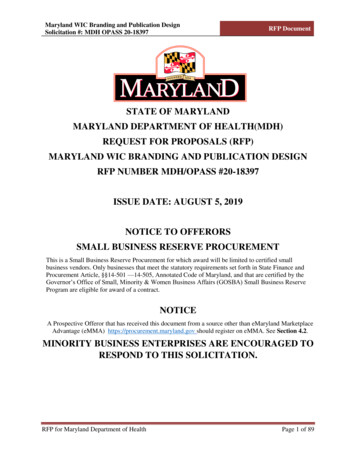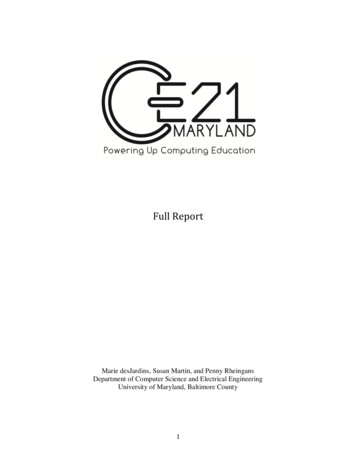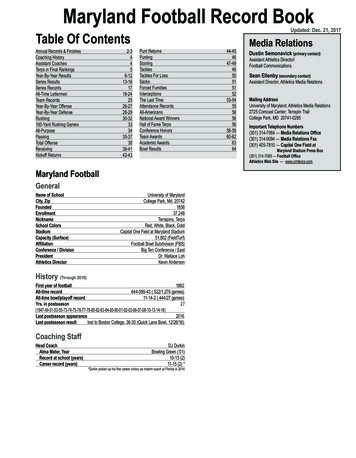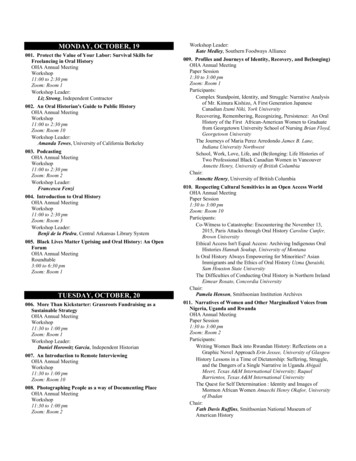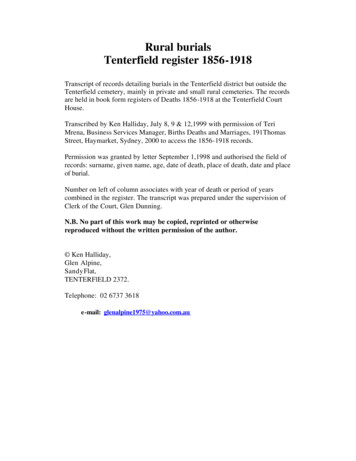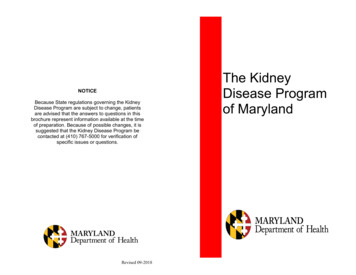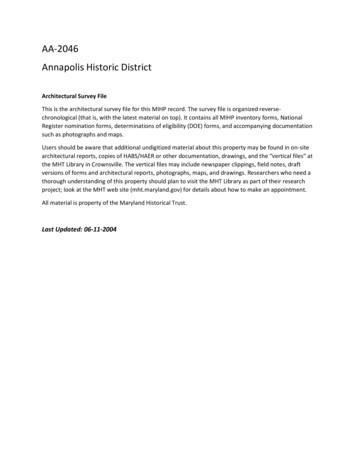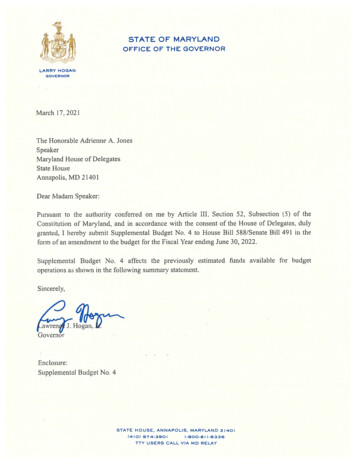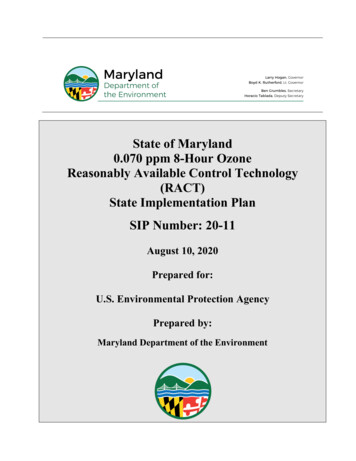
Transcription
State of Maryland0.070 ppm 8-Hour OzoneReasonably Available Control Technology(RACT)State Implementation PlanSIP Number: 20-11August 10, 2020Prepared for:U.S. Environmental Protection AgencyPrepared by:Maryland Department of the Environment
This Page Left Intentionally Blank
Table of ContentsPrologue . iii1.0INTRODUCTION . 1Background and requirements . 1Maryland’s Ozone Designation . 1CAA RACT Requirements . 3Major Source Threshold Levels . 4Responsibilities. 42.0NOX RACT SIP DETERMINATION. 6Certification of NOx RACT . 6Maryland Small Source Requirement for NOx . 6Overview of COMAR Requirements . 72.1.1Implementation of Non-CTG Specified NOx Controls . 223.0VOC RACT SIP Determination . 28Certification of VOC RACT . 283.1.1Overview of COMAR Requirements . 28CTG Sources. 293.1.2Control Technique Guideline (CTG) Requirements Not Adopted in Maryland . 51Other Area and Nonroad Mobile Sources Categories . 52Major Non-CTG Sources of and VOC . 564.0MDE INTERNAL CONSULTATION PROCESS AND EPA’S RACT/BACT CLEARINGHOUSE . 1135.0REFERENCE DOCUMENTS . 1136.0APPENDICES. 117Appendix A: RACT/BACT Clearinghouse Data Sheets . 118Appendix B: Major Sources of NOx in Maryland and Applicable RACT Regulations . 128Appendix C: VERSO Luke Paper Title V Permit Termination. 133Appendix D: COMAR 26.11.38 (EPA Approved Version) . 135Appendix E: COMAR 26.11.08.08-2 HMIWI REGULATION. 141Appendix F: Chalk Point CPCN #8228 . 174List of FiguresFigure 1: Maryland/Washington D.C./Virginia/Delaware 2015 8-hour Ozone Nonattainment Areas . 3List of TablesTable 1: Maryland’s 2015 Ozone NAAQS Designations. 2Table 2: Maryland NOx RACT Regulations under the 2015 8-Hour Ozone NAAQS . 8Table 3.1: Control Technology Guideline RACT . 30Table 3.2: Other Area Source RACT . 53Table 3.3: 2011 Major Source List . 58Page i
This Page Left Intentionally BlankPage ii
PROLOGUEThis prologue highlights Maryland’s ozone precursor emission reductions, research activities, and regionalcontributions in abating the ozone problem and should not be considered as RACT. The activities strengthenMaryland’s position in attaining and maintaining the ozone standard.Since the 1970’s Maryland has struggled to attain the ground level ozone standard. One of the major reasonsthe State has struggled is that research shows that on most bad ozone days, up to 70 percent of the ozonemeasured in Maryland originates in upwind states. For over 30 years, MDE has partnered with the Universityof Maryland College Park to study and analyze ozone transport or ozone that is carried by winds into the State.This research has used research airplanes, ozonesonde balloons, laser measurement techniques called LIDAR,ground level monitoring data and more to measure how much ozone is transported into Maryland from upwindareas.The State has made significant progress reducing ozone exposure across the State. The number of days whereozone is above the standard has dropped consistently over time.Number of Ozone Exceedance 02011201220132014201520162019The spatial extent of the State’s ozone problem has also been reduced significantly. Over the past 30 yearsozone levels across the State have improved appreciably. However, half of Maryland’s jurisdictions and themajority of the population reside in nonattainment areas for the 2015 ozone standard.Page iii
Maryland has also adopted one of the Country’s most aggressive set of VOC and NOx control programs in theCountry. These include controls on mobile sources, area sources and large and small stationary sources. Themost significant category of stationary sources in Maryland is coal-fired electric generating units. Through aseries of regulatory actions, Maryland has dramatically reduced NOx emissions from coal-fired power plants.Annual Nox Reductions at Maryland CoalFired Power Plants70,000NOx Tons Per Year60,00050,00040,00030,00020,000MarylandHealthy AirAct, 20190A significant local source category contributing to Maryland’s ozone problem is mobile sources. Thisincludes smaller vehicles, like cars, as well as larger vehicles, like trucks and construction equipment.Separate from this SIP revision, Maryland has adopted, or is working on, very aggressive mobile sourcecontrols. Examples include recent actions on aftermarket catalysts, California cars and zero-emission vehiclesfor medium and heavy duty trucks. Reducing local mobile source NOx emissions is one of MDE’s highestpriorities for attaining the 2015 ozone standard. And while these programs have brought and continue to bringimportant emissions reductions, Maryland continues to struggle to attain the ozone standard. This underscoresthe importance of continuing to seek, not only aggressive in-state reductions, but also reductions from ourupwind partners in order to achieve attainment.MDE is also looking at achieving NOx and VOC reductions using our innovative nontraditional Peak DayPartnership Program. This program is an MDE voluntary initiative where we ask key energy sources tominimize NOx emissions on specific days during the summer based upon new research and enhancements toour ozone forecasting programs. Micro-scale meteorology, like winds around the Bay and emissions sourcesthat are driven by the market to run at maximum levels is becoming a critical issue that needs to be addressed.The partnership is designed to begin a process to address this peak day issue as a low cost common senseapproach. Additional options MDE is exploring include investigating additional control options at MunicipalWaste Combustors, possible new reductions from the Baltimore Port Partnership, and potential episodiccontrols for emissions units that operate infrequently on an annual basis, but can emit NOx on peak zone dayswhen an ozone exceedance is most likely. These non-traditional emissions reductions may not be consideredRACT, but they may prove to be important for continuing to reduce ozone levels in Maryland.Page iv
While MDE continues to pursue aggressive emissions reductions, EPA’s attainment modeling for 2023continues to show Maryland struggling to attain and maintain the 2015 ozone NAAQS due, in part, toemissions from upwind states1. MDE is continuing to use all available tools provided under the Clean Air Actto push for more reductions in upwind States to reduce ozone transport. Examples of these actions include theState’s Clean Air Act Section 126 Petition, the Ozone Transport Commission’s Clean Air Act Section 184(c)recommendation based upon Maryland’s 184(c) Petition and a series of legal challenges of federal rules likethe Cross State Air Pollution Rule (CSAPR) Close-Out.For more information on the actions discussed above and other actions being undertaken by MDE to reduceozone exposure to Maryland’s citizens dex.aspx1EPA’s modeling released in a March 2018 memo titled Information on the Interstate Transport State Implementation PlanSubmissions for the 2015 Ozone National Ambient Air Quality Standards under Clean Air Act Section 110(a)(2)(D)(i)(I) shows that,using a standard methodology Maryland’s Harford County monitor will be in nonattainment for the 2015 ozone NAAQS in 2023.Using an approach modified for monitors influenced by land-water interface issues, the monitor will have issues maintaining theNAAQS. A following memo released in August 2018 titled Analysis of Contribution Thresholds for Use in Clean Air Act Section110(a)(2)(D)(i)(I) Interstate Transport State Implementation Plan Submissions for the 2015 Ozone National Ambient Air QualityStandards indicates that, for the modeled maintenance value of 70.9 ppb, 22.60 ppb comes from in-state sources while 25.88 ppbcomes from out-of-state sources.Page v
1.0 INTRODUCTIONOn October 26, 2015, EPA promulgated a revised 8-hour ozone NAAQS2 of 0.070 parts per million(ppm). This action revised the primary and secondary standards to a level of 0.070 parts per million(ppm) over an 8-hour period. The EPA’s final rule Implementation of the 2015 National AmbientAir Quality Standards for Ozone: State Implementation Plan Requirements set out the requirementsfor Reasonable Available Control Technology (RACT) State Implementation Plans3.This document consists of Maryland’s State Implementation Plan (SIP) Revision developed for thepurpose of meeting the RACT requirements set forth by the Clean Air Act (CAA), as therequirements apply to the 0.070 ppm 8-hour ozone National Ambient Air Quality Standard(NAAQS). This document is hereafter referred to as “Maryland’s 8-hour Ozone RACT SIP”, orsimply as “the RACT SIP.” This document is a revised and updated version of the NOx and VOCRACT SIPs that Maryland submitted in 2016 and 2018, respectively, in response to the 2008 0.075ppm 8-hr ozone standard.Background and requirementsGround level ozone, one of the principal components of “smog,” is a serious air pollutant that harmshuman health and the environment. High levels of ozone can damage the respiratory system andcause breathing problems, throat irritation, coughing, chest pains, and greater susceptibility torespiratory infection. High levels of ozone also cause serious damage to forests and agriculturalcrops, resulting in economic losses to logging and farming operations.Ozone is generally not directly emitted to the atmosphere; rather it is formed in the atmosphere byphotochemical reactions between volatile organic compounds (VOC) and oxides of nitrogen (NOx)in the presence of sunlight. Consequently, in order to reduce ozone concentrations in the ambientair, the CAA requires all nonattainment areas to apply controls on VOC/NOx emission sources toachieve emission reductions. This SIP discusses the controls applied to NOx emissions sources.Maryland’s Ozone DesignationOn June 4, 2018, EPA designated three areas in Maryland as “nonattainment” under the 8-hourozone NAAQS4. These nonattainment areas are; the Baltimore Nonattainment Area (classified asMarginal), the Washington D.C. Nonattainment Area (Marginal), and the PhiladelphiaNonattainment Area (Marginal). All other remaining Maryland counties are part of the OzoneTransport Region (OTR). Please reference Table 1 below.280 FR 65292, pdf/2015-26594.pdf83 FR 62998, pdf/2018-25424.pdf483 FR 25776, pdf/2018-11838.pdf3Maryland 70 ppb RACT SIPPage 1
Table 1: Maryland’s 2015 Ozone NAAQS DesignationsOzone Nonattainment Area NameMD CountiesBaltimore, MDAnne ArundelBaltimoreBaltimore lantic City, PA-NJ-MD- DE CecilWashington, DC-MD-VAMaryland 70 ppb RACT SIPCalvertCharlesFrederickMontgomeryPrince alPage 2
Figure 1: Maryland/Washington D.C./Virginia/Delaware 2015 8-hour Ozone NonattainmentAreasCAA RACT RequirementsThe U.S. Environmental Protection Agency (EPA) has defined RACT as “the lowest emissionlimitation that a particular source is capable of meeting by the application of control technology thatis reasonably available considering technological and economic feasibility”5. Section 182(b)(2) ofthe CAA, applies RACT to VOC sources in moderate or worse ozone nonattainment areas aroundthe country. Under CAA Section 184(b)(1)(B), requirements comparable to those established underSection 182(b)(2) are applicable to all areas in ozone transport regions. Under CAA Section184(b)(2) any stationary source with a potential to emit at least 50 tons per year of VOCs is subjectto RACT under CAA Section 182(b)(2)(C) if located in the following portions of ozone transportregions: those designated attainment; or, designated nonattainment and classified as either marginalor moderate nonattainment.6 Under Section 182(f), the CAA establishes that Subpart 2 requirements544 FR 53761 and 53762, September 17, 1979Nonattainment areas classified as serious or worse must implement RACT on stationary sources with a potential emitof at least 50 tons per year of VOCs irrespective of location within or outside an ozone transport region.6Maryland 70 ppb RACT SIPPage 3
applicable to major stationary sources of VOCs are also applicable to major stationary sources ofNOx. However, the threshold defining a major stationary source of NOx within ozone transportregions remains at a potential to emit at least 100 tons per year of NOx in areas designatedattainment and in nonattainment areas classified as marginal or moderate.7Under Section 183 of the CAA, EPA was required to issue by certain timeframes several guidancedocuments that would help states meet the requirements of Section 182(b)(2). This requirementupon EPA includes developing Alternate Control Techniques (ACT) documents for controls of NOxemissions from stationary sources.Information in ACT documents is available to states to consider as they establish controls onrelevant NOx sources in their moderate or worse nonattainment areas. In areas with continuingnonattainment problems, such as the Baltimore Nonattainment Area, more stringent controls havebeen adopted as RACT or as beyond RACT.Major Source Threshold LevelsMaryland is part of the Northeast Ozone Transport Region (OTR) and contains nonattainment areasclassified as “moderate” or “marginal”. For the purpose of the 2015 8-hour Ozone NAAQS, thethreshold for what constitutes a major stationary source of VOCs or NOx is that required any of thefollowing criteria: Due to an area’s nonattainment classification under the 2015 8-hour Ozone NAAQS Due to its presence in the ozone transport region due to regulations/requirements specifiedunder previous SIP commitments.8Sources in Maryland will continue to be subject to the applicability requirements of COMAR26.11.09.08A. The regulation applies to a person who owns or operates an installation that causesemissions of NOx and is located at premises that have total potential to emit:a) 25 tons or more per year of NOx and is located in Baltimore City, or Anne Arundel,Baltimore, Calvert, Carroll, Cecil, Charles, Frederick, Harford, Howard, Montgomery, orPrince George's countiesb) 100 tons or more per year of NOx and is located in Allegany, Caroline, Dorchester, Garrett,Kent, Queen Anne's, St. Mary's, Somerset, Talbot, Washington, Wicomico, or Worcestercountiesc) 25 tons or more per year of VOC and is located in Baltimore City, or Anne Arundel,Baltimore, Calvert, Carroll, Cecil, Charles, Frederick, Harford, Howard, Montgomery, orPrince George's countiesd) 50 tons or more per year of VOC and is located in Allegany, Caroline, Dorchester, Garrett,Kent, Queen Anne's, St. Mary's, Somerset, Talbot, Washington, Wicomico, or WorcestercountiesResponsibilities757 FR 55620 at 55622, November 25, 1992.Under anti-backsliding rules of 40 CFR 51.1105 stationary sources of NOX below this 100 tons per year thresholdremain subject to any applicable regulations for the control of NOX.8Maryland 70 ppb RACT SIPPage 4
The agency with direct responsibility for preparing and submitting this document is the MarylandDepartment of the Environment (MDE), Air and Radiation Administration (ARA), Air QualityPlanning Program, Managed by Mr. Brian J. Hug, Program Manager.Maryland 70 ppb RACT SIPPage 5
2.0 NOX RACT SIP DETERMINATIONCertification of NOx RACTThe Maryland Department of the Environment (MDE) has prepared this Reasonably AvailableControl Technology (RACT) analysis to demonstrate that the State has met its obligation relating tothe 2015 8-hour ozone National Ambient Air Quality Standard (NAAQS). MDE is certifying thatall RACT regulations adopted to the present date are RACT for the 2015 8-hour ozone NAAQS asthey reflect the most current pollution control technologies and economic considerations. Based onthe review of current technologies, MDE has found no data indicating that the existing levels ofcontrol for these source categories are no longer RACT.Maryland is also certifying through this SIP submittal that Maryland meets the CAA RACTrequirements for NOx sources with potential to emit 100 TPY or more.This certification is based on the following supporting information: (1) a certification thatpreviously adopted RACT controls in Maryland’s SIP and that were approved by EPA under the2008 8-hour ozone NAAQS are based on the current availability of technically and economicallyfeasible controls and that they continue to represent RACT for 2015 8-hour NAAQSimplementation purposes, and (2) the adoption of new or more stringent regulations that representRACT control levels for certain source categories.Maryland Small Source Requirement for NOxIn regulation COMAR 26.11.02 “Permits, Approvals and Registration,” Maryland has established acomprehensive review process for minor sources. By keeping the Maryland exemption thresholdlow, all other sources are included in the review process. The affected minor sources emit wellbelow the major source. The requirements of COMAR 26.11.02 ensure that all major sources arecontrolled by RACT at a minimum.Maryland 70 ppb RACT SIPPage 6
Overview of COMAR RequirementsCode of Maryland Regulations (COMAR) 26.11.09.08 represent Maryland’s NOx RACT controlsthat have been implemented and were previously approved into the Maryland SIP under the 1-hourozone NAAQS and 1997 8-hour ozone NAAQS. These regulations address NOx RACT for majorNOx sources, including but not limited to: fuel burning equipment, space heaters, glass meltingfurnaces, and industrial furnaces. A full listing of the major (high impact) NOx sources inMaryland and the corresponding RACT regulate on is included in Appendix B.Maryland also implemented additional NOx controls as part of its SIP necessary to meet otherFederal and state requirements, and which as recently revised represent NOx RACT to date underthe 2015 8-hour ozone NAAQS. Certain NOx requirements of COMAR 26.11.29 and 26.11.30currently ensure that affected cement manufacturing facilities and natural gas compressor stationsachieve RACT level reductions of at least a 30 percent and 82 percent reduction, respectively, fromuncontrolled levels (70 FR at 71653, November 29, 2005).Hospital, medical, and infectious waste incinerators (HMIWI) are subject to the RACTrequirements under 26.11.08.08-2, small municipal waste combustors (MWC) are subject to theRACT requirements under 26.11.08.07 and large municipal waste combustors (MWC) are subjectto the RACT requirements under 26.11.08.10 . Kraft pulp mills are subject to RACT requirementsthat were adopted under COMAR 26.11.14 & COMAR 26.11.40. Portions of COMAR 26.11.08.082 are being submitted for approval into the SIP. The largest coal-fired electric generating units aresubject to SIP-approved NOx requirements that were adopted under COMAR under 26.11.38, someof which MDE is certifying represent NOx RACT to date.Maryland 70 ppb RACT SIPPage 7
Basis for RACTControlCode MDE confirmsthat there are noadditionalsources at thistime seekingalternativestandards andthat MDEcontinues to relyon any alternativestandards thathave beenpreviouslyapproved into theSIP.Summary of ApplicableRACT StandardsEPA Latest SIPApproval orMDE LatestSIP nts at least asstringent as RACT level for the2015 Ozone NAAQS?It was approved by EPA asRACT under the 1997 ozonestandard. After EPA’s approvalthere has been no significantchange in RACT controltechnology for the coveredsources.This provision fully implementsNOx RACT controls over thetargeted sources.3/28/2018, 83FR 13192hour (lb/MMBTU)Gas/Oil: 0.25 lb/MMBTUCoal (dry bottom): 0.38lb/MMBTU/hrCoal (wet bottom): 1.0lb/MMBTU/hrGas only- 0.20 pounds ofNOx per Million Btu perNOx RACT standards applyto tangentially or wall-firedfuel-burning units, based onfuel:Table 2: Maryland NOx RACT Regulations under the 2015 8-Hour Ozone NAAQSSourceCategoryFuel-BurningEquipmentLocated atMajor Sources– GeneralRequirementsand Conditions1. Summary of NOxControl Technologiesand their Extent ofApplication, USEPAFebruary 1992;2. State ImplementationPlans; GeneralPreamble for theImplementation ofTitle I of the CleanAir Act Amendmentsof 1990;3. USEPAMemorandumSubject: De MinimisValues for NOxRACT, from G.T.Helms, Ozone Policyand Strategies Group,dated 1/1/1995; and4. Alternative ControlTechniques (ACT)Document, NOxEmissions fromIndustrial/Commercial/Institutional (ICI)Boilers (EPA-453/R94-022).Page 89Because SIP 15-04 was the last amend a Section of Regulation .08, the overall COMAR 26.11.09.08 Control of NOx Emissions from Major Sources approval datematches the approval of SIP 15-04Maryland 70 ppb RACT SIP
SourceCategoryFuel-BurningEquipment witha Rated HeatInput Capacityof 250MMBtu/hr orGreaterBasis for RACTControl1. Summary of NOxControl Technologiesand their Extent ofApplication, USEPAFebruary 1992;2. State ImplementationPlans; GeneralPreamble for theImplementation ofTitle I of the CleanAir Act Amendmentsof 1990;3. USEPAMemorandumSubject: De MinimisValues for NOxRACT, from G.T.Helms, Ozone Policyand Strategies Group,dated 1/1/1995; and4. Alternative ControlTechniques (ACT)Document, NOxEmissions fromIndustrial/Commercial/Institutional (ICI)Boilers (EPA-453/R94-022).Maryland 70 ppb RACT SIPCode mmary of ApplicableRACT Standards3/28/2018, 83FR 13192EPA Latest SIPApproval orMDE LatestSIP Revision93/3/2014StateEffectiveDateYes. This provision fullyimplements NOx RACT controlsover the targeted sources.Requirements at least asstringent as RACT level for the2015 Ozone NAAQS?In addition, Maryland hasadopted more stringent NOxemissions limits in COMAR26.11.38 for several of the unitsin this category, which is alsocertifying as RACT. See Section2.1.1 “Implementation of NonCTG Specified NOx Controls”for more details.It was approved by EPA asRACT under the 1997 ozonestandard. After EPA’s approvalthere has no significant change inRACT control technology for thecovered sources.NOx standards applicableby type of unit and/or fuel.CoalTangentially fired: 0.70lb/MMBTU (for high heatrelease units); 0.45lb/MMBTU (all other units)Cyclone: 0.70lb/MMBTU/hr from May 1to September 30, and 1.5lb/MMBTU for theremainder of the year.Cell burner: 0.6lb/MMBTUWall fired: 0.80lb/MMBTU (for high heatrelease units); 0.50lb/MMBTU (all other units)Oil fired or gas/oil fired:0.30 lb/MMBTUPage 9
SourceCategoryFuel-BurningEquipment witha Rated HeatInput Capacityof Less than250 MMBtu/hrand Greaterthan 100MMBtu/hrBasis for RACTControl1. Summary of NOxControl Technologiesand their Extent ofApplication, USEPAFebruary 1992;2. State ImplementationPlans; GeneralPreamble for theImplementation ofTitle I of the CleanAir Act Amendmentsof 1990;3. USEPAMemorandumSubject: De MinimisValues for NOxRACT, from G.T.Helms, Ozone Policyand Strategies Group,dated 1/1/1995; and4. Alternative ControlTechniques (ACT)document, NOxEmissions fromIndustrial/Commercial/Institutional (ICI)Boilers (EPA-453/R94-022).Maryland 70 ppb RACT SIPCode mmary of ApplicableRACT Standards3/28/2018, 83FR 13192EPA Latest SIPApproval orMDE LatestSIP Revision911/11/2002StateEffectiveDateYes. This provision fullyimplements RACT NOx controlsover the targeted sources.Requirements at least asstringent as RACT level for the2015 Ozone NAAQS?It was approved by EPA asRACT under the 1997 ozonestandard. After EPA’s approvalthere has been no updated ACTand no significant change inRACT control technology for thecovered sources.For coal fired fuel-burningequipment: The installationand operation of theaffected unit in accordancewith the manufacturer'sspecifications, combustionmodifications, or othertechnologies to meet anemission rate of 0.65lb/MMBTU.For all other: compliancewith 26.11.09.08B(1)(c).P a g e 10
SourceCategoryFuel-BurningEquipment witha Rated HeatInput Capacityof 100MMBtu/hr orLessBasis for RACTControl1. Summary of NOxControl Technologiesand their Extent ofApplication, USEPAFebruary 1992;2. State ImplementationPlans; GeneralPreamble for theImplementation ofTitle I of the CleanAir Act Amendmentsof 1990;3. USEPAMemorandumSubject: De MinimisValues for NOxRACT, from G.T.Helms, Ozone Policyand Strategies Group,dated 1/1/1995; and4. Alternative ControlTechniques (ACT)document, NOxEmissions fromIndustrial/Commercial/Institutional (ICI)Boilers (EPA-453/R94-022).Maryland 70 ppb RACT SIPCode mmary of ApplicableRACT StandardsEPA Latest SIPApproval orMDE LatestSIP Revision9Applicable NOx RACT3/28/2018, 83standards include:FR 13192Performing a combustionanalysis for each installationat least once each year andoptimizing combustionbased on the analysis.9/18/2000StateEffectiveDateYes. This provision fullyimplements NOx RACT controlsover the targeted sources.Requirements at least asstringent as RACT level for the2015 Ozone NAAQS?It was approved by EPA asRACT under the 1997 ozonestandard. After EPA’s approvalthere has been no significantchange in RACT controltechnology for the coveredsources.P a g e 11
SourceCategorySpace HeatersBasis for RACTControl1. Summary of NOxControl Technologiesand their Extent ofApplication, USEPAFebruary 1992;2. State ImplementationPlans; GeneralPreamble for theImplementation ofTitle I of the CleanAir Act Amendmentsof 1990;3. USEPAMemorandumSubject: De MinimisValues for NOxRACT, from G.T.Helms, Ozone Policyand Strategies Group,dated 1/1/1995; and4. Alternative ControlTechniques (ACT)document, NOxEmissions fromIndustrial/Commercial/Institutional (ICI)Boilers (EPA-453/R94-022).Maryland 70 ppb RACT SIPCode mmary of ApplicableRACT Standards3/28/2018, 83FR 13192EPA Latest SIPApproval orMDE LatestSIP Revision99/18/2000StateEffectiveDateYes. This provision fullyimplements NOx RACT controlsover the targeted sources.Requirements at least asstringent as RACT level for the2015 Ozone NAAQS?It was approved by EPA asRACT under the 1997 ozonestandard. After EPA’s approvalthere has been no significantchange in RACT controltechnology for the coveredsources.Applicable NOx RACTstandards include:Developing an operatingand maintenance plan tominimize NOx emissionsbased on therecommendations ofequipment vendors andother information includingthe source's operating andmaintenance experience;implementing the operatingand maintenance plan.P a g e 12
SourceCategoryFuel-BurningEquipment witha CapacityFactor of 15Percent or LessBasis for RACTCo
simply as "the RACT SIP." This document is a revised and updated version of the NOx and VOC RACT SIPs that Maryland submitted in 2016 and 2018, respectively, in response to the 2008 0.075 ppm 8-hr ozone standard. Background and requirements Ground level ozone, one of the principal components of "smog," is a serious air pollutant that harms


